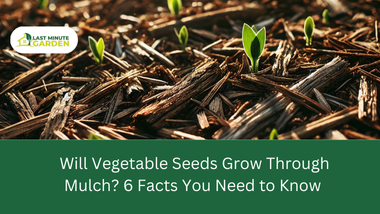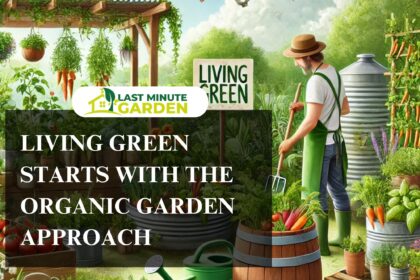Ever planted vegetable seeds only to find them struggling under a thick layer of mulch? It’s a common scenario, but will vegetable seeds grow through mulch by laying down the garden beds well for effective seed push through the surface?
So, will vegetable seeds grow through mulch? The answer depends on several factors, including the type of mulch, the depth, and how you approach planting. Mulch offers many benefits like moisture retention and weed control, but can it be an obstacle for your seeds?
Let’s take a look at 6 facts that will clear this pressing question to enable you to make the best decision for your vegetable garden.
1. Mulch Can Protect Seeds, But It Can Also Hinder Germination
Mulch serves as a barrier between your soil and the outside elements. It keeps the soil temperature stable and retains moisture, both of which are crucial for seed germination.
But if the mulch layer is too thick, it may prevent seeds from getting the light and airflow they need to sprout.
Thin layers of mulch can help protect seeds from drying out, but a dense, heavy layer can suffocate those tiny sprouts before they have a chance to emerge.
If you’re sowing small seeds like lettuce or carrots, ask yourself will vegetable seeds grow through mulch? When planting these seeds the use of a lighter layer of mulch or waiting until the seedlings have sprouted before adding it is essential. This way, you get the benefits of mulch without the risk of burying your seeds too deep.
2. Mulch Type Matters for Seed Growth
Not all mulches are created equal, and the type you use can make a difference in how well seeds push through.
Organic mulches, like straw or shredded leaves, tend to be lighter and more breathable. They break down over time, adding nutrients to the soil and making it easier for seeds to grow through them.
On the other hand, wood chips and bark mulches are heavier and denser. These materials are excellent for established plants, but they can make it tough for tender seedlings to break through.
If you’re using these types of mulch, try keeping them away from freshly sown seeds. Instead, create a small mulch-free zone over your seed rows, allowing them to germinate without obstruction.
3. Direct-Sown Seeds May Struggle More Than Transplants
One of the key questions gardeners face is whether to direct-sow seeds or transplant seedlings into the garden. Mulch has a different impact on each approach.
Direct-sown seeds, which you plant directly into the soil, have to contend with the mulch layer right from the start. They need to push through both the soil and the mulch before they can reach the light, which can make their early growth slower.
Transplants, on the other hand, already have a head start. They come with a bit of height and strength. So will vegetable seeds grow through mulch to make them easier for their mulch layer.
For this reason, many gardeners prefer to sow seeds indoors or in a controlled environment before transplanting them into the garden, especially if they plan to use a thick mulch cover.
This method offers better control over the growing conditions and makes the transition to the mulched garden bed smoother.
4. Timing Is Key for Adding Mulch
Timing plays a major role in the success of seeds growing through mulch. Adding mulch right after planting can hinder the growth of many types of vegetables.
It is often better to wait until seedlings have emerged and developed a few sets of true leaves before adding mulch around them. This allows the young plants to establish themselves without being smothered by the mulch layer.
For heat-loving plants like tomatoes and peppers, a little bit of bare soil in the early stages can speed up growth, as exposed soil absorbs more sunlight.
Once the seedlings are strong and temperatures rise, then you can add mulch to help keep the roots cool and conserve moisture.
5. Mulch Depth Can Make or Break Seed Success
The depth of your mulch layer is just as important as the type you use. For vegetable seeds to grow through mulch, aim for a layer no thicker than 2 to 3 inches.
This allows the mulch to serve its purpose without being a barrier to new growth. A deeper layer might be tempting for weed control, but it can also keep seedlings from emerging.
Keep an eye on your garden after planting. If you notice seeds struggling to break through the mulch, gently push aside some of the material to give them a better shot.
Once the seedlings are strong enough, will vegetable seeds grow through mulch as you reapply the mulch around their base, creating a comfortable environment for their continued growth.
6. Mulch Quality Influences Seed Success
Not all mulches are created equal when it comes to quality. Organic mulch that’s free of contaminants and chemicals provides a healthier environment for your vegetable seeds.
Some commercial mulches contain dyes or additives that can alter soil pH or introduce unwanted elements into your garden.
When buying mulch, look for natural, untreated options that break down into the soil without leaving residues behind.
This helps create a healthier soil ecosystem that benefits both seeds and mature plants. Homemade mulch, like grass clippings or fallen leaves from your yard, can be a great alternative, as long as you’re sure they haven’t been treated with chemicals.
A garden that uses high-quality organic mulch can provide a rich environment that supports seed germination and growth, without the drawbacks of synthetic materials. It’s a small investment that can yield better results for your garden in the long run.
Summary
So, will vegetable seeds grow through mulch? The answer depends on several factors, including the type of mulch, the depth, and how you approach planting.
Think of mulch as a tool that needs to be used thoughtfully. When used correctly, it can be an ally in your gardening efforts, helping to maintain soil health, reduce water usage, and keep weeds under control. But if used without consideration, it can hinder the very growth you hope to see
Choose the right type and amount of mulch, time its application carefully, and enjoy a thriving vegetable garden that benefits from both the protection of mulch and the fresh growth of new seedlings.
.





